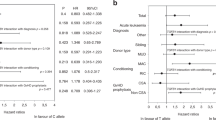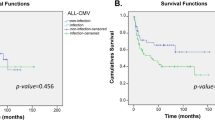Abstract
Treatment-related mortality (TRM) is a major obstacle to successful allogeneic hematopoietic stem cell transplantation (HSCT). A variety of drugs are used in allogeneic HSCT, and a genetic polymorphism in metabolic enzymes could affect the metabolism of drugs and potentially influence TRM. Here, we focused attention on GSTM1 and GSTT1 enzymes, which metabolize chemotherapeutic agents, chemical carcinogens and by-products of oxidative stress and are absent from more than 50% of some populations. To assess the significance of homozygous GSTM1 and GSTT1 gene deletion in HSCT, we analyzed DNA from 373 patients with hematological disease and their HLA-identical unrelated bone marrow donors using PCR. Homozygous GSTM1 and GSTT1 gene deletions were observed in 56 and 45% of patients, respectively, and 57 and 46% of donors, respectively. There was no significant association between GSTT1 polymorphism and any outcome. However, a GSTM1-positive genotype in recipients was significantly associated with higher TRM and lower survival. These results suggest that a GSTM1-null genotype in recipients protects against TRM after allogeneic HSCT. Further studies are needed to elucidate a mechanism of increased risk for TRM in GSTM1-positive recipients.
This is a preview of subscription content, access via your institution
Access options
Subscribe to this journal
Receive 12 print issues and online access
$259.00 per year
only $21.58 per issue
Buy this article
- Purchase on Springer Link
- Instant access to full article PDF
Prices may be subject to local taxes which are calculated during checkout


Similar content being viewed by others
References
Storb R, Deeg HJ, Whitehead J, Appelbaum F, Beatty P, Bensinger W et al. Methotrexate and cyclosporine compared with cyclosporine alone for prophylaxis of acute graft versus host disease after marrow transplantation for leukemia. N Engl J Med 1986; 314: 729–735.
Murata M, Warren EH, Riddell SR . A human minor histocompatibility antigen resulting from differential expression due to a gene deletion. J Exp Med 2003; 197: 1279–1289.
Terakura S, Murata M, Nishida T, Emi N, Akatsuka Y, Riddell SR et al. A UGT2B17-positive donor is a risk factor for higher transplant-related mortality and lower survival after bone marrow transplantation. Br J Haematol 2005; 129: 221–228.
Hayes JD, Flanagan JU, Jowsey IR . Glutathione transferases. Annu Rev Pharmacol Toxicol 2005; 45: 51–88.
Board PG . Biochemical genetics of glutathione-S-transferase in man. Am J Hum Genet 1981; 33: 36–43.
Pemble S, Schroeder KR, Spencer SR, Meyer DJ, Hallier E, Bolt HM et al. Human glutathione S-transferase theta (GSTT1): cDNA cloning and the characterization of a genetic polymorphism. Biochem J 1994; 300: 271–276.
Naoe T, Takeyama K, Yokozawa T, Kiyoi H, Seto M, Uike N et al. Analysis of genetic polymorphism in NQO1, GST-M1, GST-T1, and CYP3A4 in 469 Japanese patients with therapy-related leukemia/myelodysplastic syndrome and de novo acute myeloid leukemia. Clin Cancer Res 2000; 6: 4091–4095.
Sasazuki T, Juji T, Morishima Y, Kinukawa N, Kashiwabara H, Inoko H et al. Effect of matching of class I HLA alleles on clinical outcome after transplantation of hematopoietic stem cells from an unrelated donor Japan marrow donor program. Engl J Med 1998; 339: 1177–1185.
Morishima Y, Sasazuki T, Inoko H, Juji T, Akaza T, Yamamoto K et al. The clinical significance of human leukocyte antigen (HLA) allele compatibility in patients receiving a marrow transplant from serologically HLA-A, HLA-B, and HLA-DR matched unrelated donors. Blood 2002; 99: 4200–4206.
Sullivan KM, Shulman HM, Storb R, Weiden PL, Witherspoon RP, McDonald GB et al. Chronic graft-versus-host disease in 52 patients: adverse natural course and successful treatment with combination immunosuppression. Blood 1981; 57: 267–276.
Przepiorka D, Weisdorf D, Martin P, Klingemann HG, Beatty P, Hows J et al. 1994 Consensus conference on acute GVHD grading. Bone Marrow Transplant 1995; 15: 825–828.
Cox DR . Regression models and life-tables. J R Stat Soc Ser B 1972; 34: 187–220.
Kaplan EL, Meier P . Nonparametric estimation from incomplete observations. Am Stat Assoc J 1958; 53: 457–481.
Srivastava A, Poonkuzhali B, Shaji RV, George B, Mathews V, Chandy M et al. Glutathione S-transferase M1 polymorphism: a risk factor for hepatic venoocclusive disease in bone marrow transplantation. Blood 2004; 104: 1574–1577.
Qiu R, Yao A, Vicini P, McDonald GB, Batchelder AL, Bouvier ME et al. Diminishing the risk of nonrelapse mortality in hematopoietic stem cell transplantation: Prediction of exposure to the cyclophosphamide metabolite carboxyethylphosphoramide mustard. Clin Pharmacol Ther 2004; 76: 270–280.
Katoh T, Nagata N, Kuroda Y, Itoh H, Kawahara A, Kuroki N et al. Glutathione S-transferase M1 (GSTM1) and T1 (GSTT1) genetic polymorphism and susceptibility to gastric and colorectal adenocarcinoma. Carcinogenesis 1996; 17: 1855–1859.
Chen H, Sandler DP, Taylor JA, Shore DL, Liu E, Bloomfield CD et al. Increased risk for myelodysplastic syndromes in individuals with glutathione transferase theta 1 (GSTT1) gene defect. Lancet 1996; 347: 295–297.
Ye Z, Song H . Glutathione S-transferase polymorphisms (GSTM1, GSTP1 and GSTT1) and the risk of acute leukaemia: a systematic review and meta-analysis. Eur J Cancer 2005; 41: 980–989.
Takatsuka H, Yamada S, Okamoto T, Fujimori Y, Wada H, Iwata N et al. Predicting the severity of intestinal graft-versus-host disease from leukotriene B4 levels after bone marrow transplantation. Bone Marrow Transplant 2000; 26: 1313–1316.
Acknowledgements
We thank the staff of transplant and donor centers, and JMDP. We also thank Dr Stanley R Riddell for critical reading of the manuscript. This work was supported by a grant from the Ministry of Health, Labour and Welfare of Japan (MM and YK).
Author information
Authors and Affiliations
Corresponding author
Rights and permissions
About this article
Cite this article
Terakura, S., Murata, M., Nishida, T. et al. Increased risk for treatment-related mortality after bone marrow transplantation in GSTM1-positive recipients. Bone Marrow Transplant 37, 381–386 (2006). https://doi.org/10.1038/sj.bmt.1705257
Received:
Revised:
Accepted:
Published:
Issue Date:
DOI: https://doi.org/10.1038/sj.bmt.1705257
Keywords
This article is cited by
-
Analysis of glutathione S-transferase and cytochrome P450 gene polymorphism in recipients of dose-adjusted busulfan-cyclophosphamide conditioning
International Journal of Hematology (2020)
-
Identification and Utilization of Donor and Recipient Genetic Variants to Predict Survival After HCT: Are We Ready for Primetime?
Current Hematologic Malignancy Reports (2015)
-
Decreased risk of acute graft-versus-host disease following allogeneic hematopoietic stem cell transplantation in patients with the 5,10-methylenetetrahydrofolate reductase 677TT genotype
International Journal of Hematology (2008)



